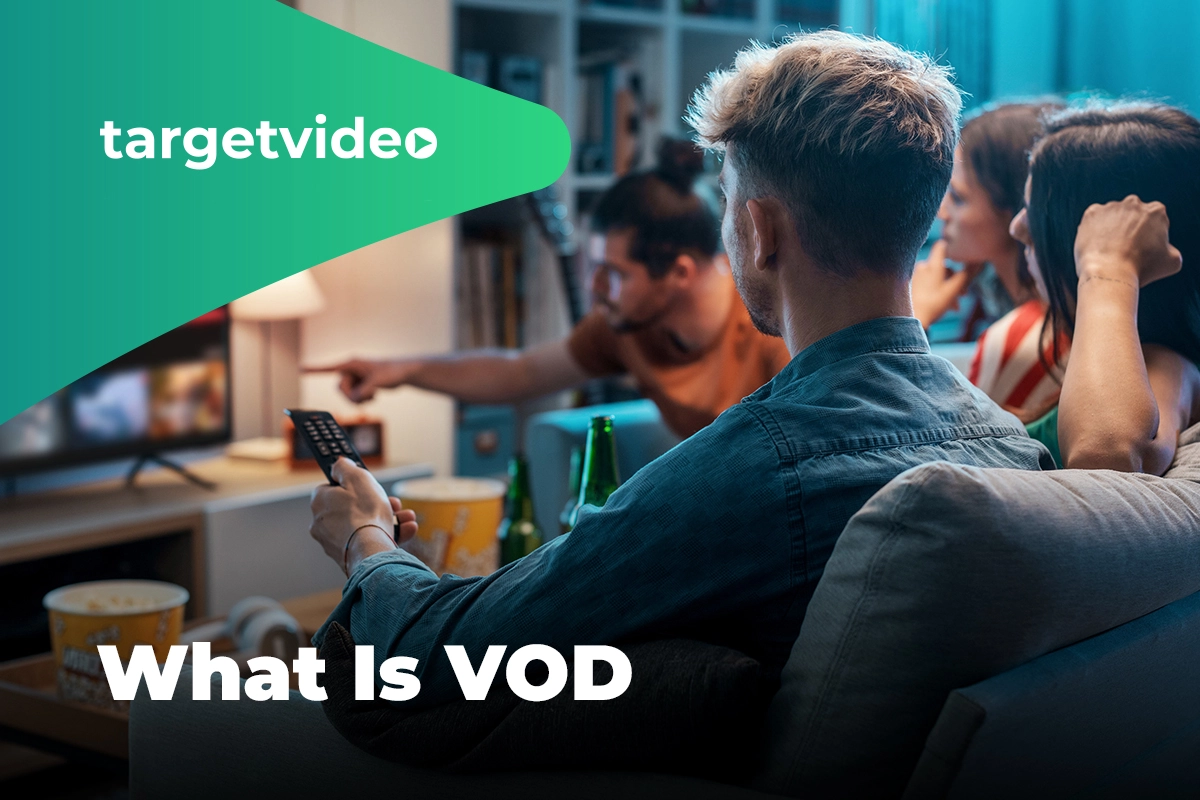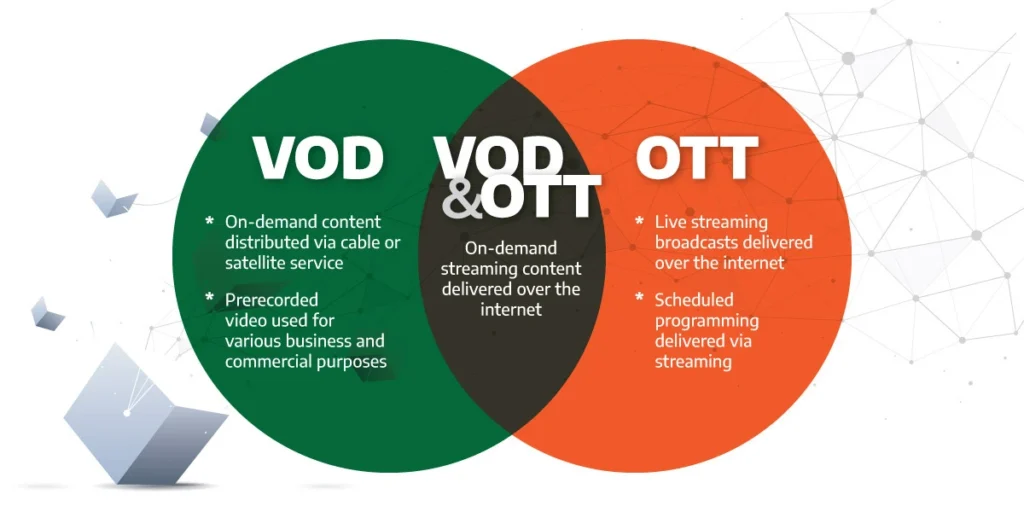
Whether it’s entertainment, education, or business, online videos are reshaping the way users spend time online. And much of this boom is the result of the convenience of VOD, i.e., video on demand. But what is VOD bringing to the table to gain such momentum in the digital sphere? From engagement boosting to generating revenue, let’s dive into the benefits VOD offers to digital publishers.
What Is VOD and How Does It Work?
VOD, or video-on-demand, allows users to access video content whenever they want (hence the on-demand part), unlike linear TV, which has a set schedule. VOD delivery works using a complex system consisting of a video player, compressing and decompressing technology, and a server.
First, to make the content accessible to their audience, publishers have to upload and host videos on a server. I suggest having a video library, either in the form of a website or an OTT app, from which users can pick and access the content they want to watch. Once a user selects a video, the HTML5 player sends a request to the server. The server sends a compressed video file back to the player, where it is decompressed.
Additional processes may occur depending on the specific streaming service. For instance, if ads are enabled, the player will also send an ad request to the publisher’s ad server. If DRM (digital rights management) protection is in place, the player will request a decryption key.
Video on Demand vs. Live Streaming
Live streaming and video-on-demand (VOD) are fundamentally different, with the main difference being that live streaming happens in real time, while VOD uses pre-recorded content. Both deliver video files in “packages,” but live streams encode these packages in real-time, whereas VOD uses stored files.
However, these two can sometimes meet in the middle. Many publishers host live streams that viewers watch in real-time and afterward make these streams available as on-demand content. This attracts a wider audience (both users who want to watch things as they happen, and those who can’t make the time to view content in real-time), and gives publishers a variety of monetization opportunities.
Video on Demand vs. OTT

The terms VOD and OTT are often used interchangeably. However, while they are intertwined, they denote different things. VOD refers to on-demand access to any video content. OTT broadcasting, on the other hand, denotes a content distribution method (over-the-top) that relies on the internet, rather than cable or satellite, to deliver video content. OTT streaming services usually contain on-demand content. Netflix, Hulu, and Disney+ are just some examples.
Video on Demand vs. Pay-Per-View
Another term that often gets confused with VOD is PPV, also known as pay-per-view. PPV is one of several video monetization models for VOD content. It is a type of transaction-based monetization where users purchase one-time access to an on-demand piece of content. My suggestion to publishers is to apply this monetization model to premium content and pre-release access since those types of content are more likely to attract a PPV audience.
Why You Should Feature VOD on Your Website
Publishers are always looking for ways to engage users on their websites and stay ahead of the competition. And featuring VOD on their websites is a great strategy. VOD can attract and retain visitors, improve search engine rankings, generate revenue, and more. The following are the key advantages of featuring VOD on your website:
- Enhances User Engagement — In recent years, video has become one of the most popular online formats with an audience reach of 92%. This is because videos provide a more interactive and engaging experience than text or static images. In addition, videos keep users interested for longer, reducing bounce rates and increasing the time spent on the website.
- Improves Website SEO — Search engines favor multimedia content, so incorporating VOD can help improve your rankings. Additionally, videos often generate more shares and backlinks, driving more organic traffic to your website.
- Increases Revenue Opportunities — Publishers can monetize their videos through video ads (instream ads, banner ads, and native), subscriptions, and so on. This gives them a great opportunity to earn from video, increasing their overall revenue.
- Extends Your Reach — Videos can easily be shared across various platforms, social media, apps, etc. This shareability allows publishers to broaden their reach and helps increase the visibility of their websites.
You May Also Like: How to Put Video Ads on Your Website
How to Monetize VOD
VOD content is relatively easy to monetize. However, with several types of video-on-demand monetization available, choosing the right one can have a great impact on your potential VOD revenue. The following are the main VOD monetization models.
Advertising Video on Demand (AVOD)

With AVOD, users have to watch ads in exchange for access to the content. These ads can show up before, during, or after a video stream ( pre-roll, mid-roll, and post-roll ads). Ad-supported content is often free (although this isn’t always the case).
Subscription Video on Demand (SVOD)

SVOD is based on recurring payments from users who want to access the content library. Publishers can designate several subscription plans at various price points. However, note that for the SVOD model, you need to constantly update your content so as not to lose the interest of your subscribers. This model is more favorable to larger publishers with abundant video libraries.
Transaction Video on Demand (TVOD)

TVOD is another payment-based model. However, rather than recurring subscriptions, this model relies on individual transactions. Users can purchase one-time or time-limited access to a piece of content. Once they have accessed the video or the access timeframe has run out, they won’t be able to watch the video again. TVOD is best used for premium content that cannot be found elsewhere, as well as for PPV live streams.
Hybrid VOD Monetization
Hybrid monetization refers to using two or more basic monetization models on one platform/website. For instance, AVOD works great with other monetization models. Publishers often choose to offer limited, ad-supported content for free, while also allowing users to subscribe to bypass ads and get access to an even larger library. There is also the reverse option of making your content more affordable like Netflix did by introducing a lower-tiered subscription model that includes ads.
How to Start a VOD Platform?
For publishers interested in launching their own VOD business, I decided to share a step-by-step guide to get them started. Here is what you need to do to launch a VOD platform:
1. Source Engaging Video Content
You can’t launch a video business without videos, right? That’s why you’ll need to come up with a video-sourcing strategy to ensure you have quality content to offer to your audience. You can either invest in production, purchase the copyrights to third-party videos, or lease the license to stream someone else’s content.
I recommend finding a provider or platform that offers a rich and versatile video library as part of their service. For instance, TargetVideo’s video content library boasts thousands of original videos across different content verticals (health, DIY, parenting, auto, sport, etc.,) so you won’t need to worry about brand safety and running out of engaging content.

2. Find a Reliable Hosting Service
The second order of business is finding a secure and reliable video hosting provider. Of course, you can always host the library on your own server, but that is bound to run up the costs and even slow down your website. With an enterprise video hosting platform, you will only incur a fraction of the cost.
3. Build a Video-on-Demand Website and App
Building a VOD website is a process similar to building any other website, especially if you’re using third-party hosting services. However, an important thing to keep in mind is monetization service integration. Depending on your chosen monetization method, you might need to integrate a paywall and invest in extra security.
On top of a VOD website, you might also want to consider launching apps for mobile devices and CTVs to truly maximize your audience reach. However, keep in mind that launching an OTT app is a more complex process. That is, unless you find an OTT platform with white-label OTT solutions.
Interested in Launching Your Own OTT App? Launch your ad-supported streaming service with the TargetVideo white-label OTT app. Grow your viewership and allow users to rate videos, create playlists, sign up, and enjoy your content on any Android, iOS, Apple TV, Tizen, or WebOS device.
4. Get a Video Player for Your VOD Website
The last — and, arguably, most important — item on the checklist is having an online video player. Your audience will need a way to view your content, and the player will make that possible. In addition to this, if you choose to monetize videos through AVOD, the player will be tasked with showing ads.
If you have the know-how and the time, you can create a video player from scratch. Alternatively, there are many ready-made white-label solutions on the internet that you can use. While there are free video players available to those who need them, a premium player usually has additional (and often necessary) features such as security measures, video ad-serving capabilities, customization options, and so on.
Another major perk of high-end premium video players is analytics. A good player will provide the publisher with in-depth data on video consumption, audience behavior, and so on. This information helps publishers correctly estimate and improve the performance of their content.
Launch a VOD Streaming Service With TargetVideo
Finding a provider for each step of the way can be a hassle. So to avoid complications, my suggestion is to find a provider that has all the services you need wrapped in one. That’s why the TargetVideo Platform offers an all-in-one solution to publishers looking to launch their own VOD streaming services. With a superior HTML5 player, a rich video library, and an array of monetization capabilities, the TargetVideo platform is the perfect solution for your website.


Reliable video-on-demand solution:
– Video Hosting
– High-Quality Streaming
– Content Management
– Ad-Powered Monetization
FAQ
1. What is video-on-demand (VOD)?
Video-on-demand, also known as VOD, is a video distribution method that allows users to access video content whenever they want to, rather than following a predetermined schedule.
2. How does video-on-demand work?
Video-on-demand works through a communication channel between the end user’s video player and the publisher’s server. When a user requests access to the video, the player forwards this request to the server, which, in turn, sends back the requested video file.
3. What is the difference between video-on-demand and streaming?
Video-on-demand is a type of streaming that takes place when a user accesses a video. Another type of streaming is live streaming, where users have to access content as it is being produced.
4. Is YouTube video on demand?
YouTube is mainly a video-on-demand platform where users can watch videos whenever they want to. However, YouTube does also host live streams, and it also has live-to-VOD capabilities.
5. Is video-on-demand free?
Video-on-demand can be free for users if it is monetized through ads, as is the case with YouTube. However, it can also be a paid service, such as Netflix or Hulu.
6. What are the best video-on-demand platforms?
The best video-on-demand platforms are TargetVideo, Dacast, and Uscreen.
* This article was originally published here

